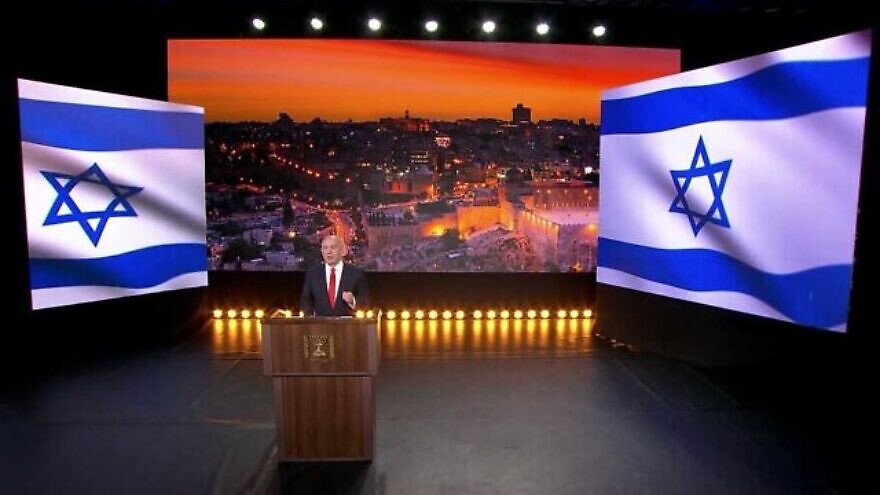By Yaakov Lappin

(October 1, 2020 / JNS) Israel’s latest exposure of the location of three precision-guided missile sites, which are embedded in heavily built-up areas of Beirut, was officially directed at the international community and at Lebanese civilians, and appeared to be a call to action. But it can also be seen as a veiled warning to Hezbollah itself, aimed at getting it to stand down from its dangerous attempts to exact vengeance against the Israel Defense Forces.
During his on speech on Tuesday to the U.N. General Assembly, Israeli Prime Minister Benjamin Netanyahu used the global stage to reveal the whereabouts of secret missile sites. His speech was soon followed by a detailed IDF video showing the exact location of the sites under residential buildings and in close proximity to many civilians.
Netanyahu placed Hezbollah’s total infiltration of the Lebanese state, as well as its conversion of Lebanon into a forward Iranian-run attack base, in the wider regional context, stating that Iran’s terror proxies are directly involved in violence throughout the Middle East, including in Iraq, Syria, Yemen, Gaza and Lebanon.
This highlighting of the radical Iranian axis is a reminder of the fact that Tehran’s network remains active throughout the Middle East, although it is facing an increasingly well-defined coalition of moderate Sunni states and Israel.
Zooming in on Lebanon, Netanyahu referenced the disastrous Aug. 4 blast at Beirut’s seaport, which killed nearly 200 people, injured thousands and left hundreds of thousands of Beirut residents homeless.
“Now, here is where the next explosion could take place. Right here,” said Netanyahu, standing alongside a map of the Lebanese capital. “This is the Beirut neighborhood of Janah. It’s right next to the international airport. And here, Hezbollah is keeping a secret arms depot. This secret arms depot, right here, is adjacent, a meter away, from a gas company. These are gas canisters. Right here. It’s a few meters away from a gas station. It’s fifty meters away from the gas company. Here are more gas trucks. And it’s embedded in civilian housing here, civilian housing here. For the Janah neighborhood residents, this is the actual coordinates.”
Netanyahu’s next message was intended to stir opposition to Hezbollah’s actions among Beirut’s residents, against their use by Hezbollah as human shields for missile sites: “I say to the people of Janah, you’ve got to act now. You’ve got to protest this. Because if this thing explodes, it’s another tragedy.”
Netanyahu’s address comes just days after a Hezbollah weapons depot exploded in the southern Lebanese village of Ain Qana. In 2019, Israel’s Ambassador to the United Nations Danny Dannon warned that “Iran and its Quds Force have been exploiting civilian maritime channels, and specifically the Port of Beirut. The Iranian regime is transferring weapons in various ways. They use commercial companies, mainly from Europe, to support Hezbollah and develop its missile program. Unfortunately, the port of Beirut has become Hezbollah’s port.”
A top-priority Israeli security concern
The timing of Netanyahu’s latest statement cannot be divorced from the current impasse between the IDF and Hezbollah. Tensions have been extremely high for months along the Israeli-Lebanese border due to Hezbollah chief Hassan Nasrallah’s insistence of enforcing his “equations” on Israel, according to which, any Hezbollah personnel killed in Israeli air strikes in Syria will trigger “proportionate” retaliation by Hezbollah against the IDF.
Hezbollah, as well as the Iranian Quds Force, have repeatedly attempted to implement this “equation” in recent months through failed border attacks, following the death of a Hezbollah member in an alleged Israeli airstrike on an Iranian weapons site in Syria in July. Each time so far, they have run into a prepared IDF on high alert and able to spot the threat in time as a result of an array of field intelligence and situational awareness capabilities.
Now, with IDF officials warning that any successful Hezbollah attack will trigger a firm, painful Israeli response—and that Israel will not accept Hezbollah’s equations—the ball is in Nasrallah’s court.
Israel’s latest message about the location of the missile sites can also be seen as timely reminder of the scope of the IDF’s intelligence penetration of Hezbollah and its deep awareness of the organization’s activities across Lebanon.
Jerusalem has repeatedly warned that it will not tolerate the presence of precision-guided missile factories on Lebanese soil, and the messages must be seen as direct warnings to both Hezbollah and Iran to cease work in the missile-production sites. Such sites could end up being targets in any major future escalation, which could begin with a Hezbollah border strike that triggered an escalation dynamic.
It is worth noting that the precision-guided missile (PGM) program, led by Hezbollah and Iran jointly, forms a top-priority Israeli security concern since allowing Hezbollah to possess such weapons would give it the ability to accurately target strategic sites deep inside Israel.
The PGM project includes the effort to convert existing unguided rockets into guided missiles, as well as building an array of missile manufacturing sites in Lebanon and shielding it by planting the facilities in the middle of civilian areas, often under residential buildings.
In addition to the site in the Janah neighborhood, Israel revealed an underground PGM site that is situated underneath a seven-story residential building, where more than 70 families live. The building stands right next to a medical center and a church.
A third site, build underneath a five-story residential building housing some 50 families, is located next to a mosque.
Ultimately, Israel hopes that Hezbollah internalizes the risk that it would be taking by attempting another border attack, while marking out for the entire world its cynical use of Lebanon’s embattled civilians as shields for a dangerous industry of guided missiles.

No comments:
Post a Comment